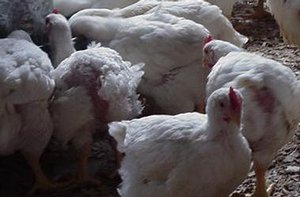Avian Influenza
Avian influenza, though a recent concern, has appeared from time to time in regions all over the world, including in the United States. Avian flu spreads easily among wild birds, but can also infect domesticated birds including chickens, turkeys, ducks, and pet birds. Humans and a variety of other mammals are also affected. Because it is highly pathogenic and viral, avian influenza can devastate entire flocks of poultry, though it is uncommon in most commercial poultry and most identified with poultry raised outdoors.

Most often spread via direct contact between healthy birds and infected birds, avian flu may be spread indirectly through contact with contaminated equipment and materials. The virus is found in secretions from the nares (nostrils), mouth, and eyes of infected birds and is also excreted in their feces. Contact with contaminated fecal matter is the most common means of bird-to-bird transmission, though airborne secretions are another major means of transmission within poultry houses.
The most virulent form of avian flu can be spread from birds to people as a result of extensive direct contact with infected birds (i.e. de-feathering during home slaughter of poultry). Fortunately; however, transmission of the flu to humans is rare. Because the virus is found in the droppings, nasal secretions, and saliva of infected birds, bird-to-human transmission most commonly occurs when particles from contaminated feces are inhaled. Inhalation and contamination of mucous membranes such as eyelids are the most common routes of infection for humans. Currently, the risk of contracting avian flu for anyone who does not have close contact with infected poultry is quite low. Although human-to-human transmission is theoretically possible, so far, there are only a few cases where human-to-human transmission is thought to have occurred.
Although dogs and cats are not usually susceptible to influenza type infections, there have been cases of cats contracting avian flu. In each case, however, the cat either consumed raw meat from an infected bird or lived in an animal shelter in close proximity to infected chickens. Since the dangerous strain of avian flu that has been circulating in Asia, the Middle East, Africa and Europe has not yet been identified in the United States, the risk of a cat contacting the disease in this country is currently very low. Preliminary recommendations for cat owners living in high risk areas include keeping domestic cats indoors, avoiding contact with semi-domestic and feral cats and refrain from feeding raw poultry to cats. Owners are also encouraged to have their cats examined by a veterinarian if they have been exposed to sick or dead birds.
[ Search Articles ] [ Article Index ]
